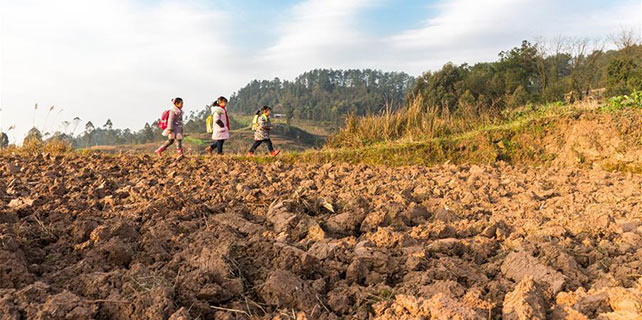Human rights record of the United States in 2016
 |
|
Women chant and raise their signs during a rally for equality on Wednesday, also International Women's Day, in New York.[KATHY WILLENS/ASSOCIATED PRESS] |
V. Women, Children, Elders' Rights Lack Proper Protection
The situation of protection of rights of women, children and elders in the US was worrisome in 2016. Women were paid much less compared to their male colleagues who do the same work, and they frequently fell victims to sexual harassment and assault. Poverty rate among children remained high and cases of elder abuse happened from time to time.
Gender pay gaps remained large. Women were paid much less compared with their male colleagues who do the same work in 2016 (www.washingtonpost.com, March 8).
An analysis found women with city government jobs in New York made 18 percent less than men (http://www.nydailynews.com, April 11, 2016).
Gender pay gap among supervisor staff in San Diego was even wider. Women who work for San Diego County supervisors earned about $37,000 less in pretax pay per year on average (www.sandiegouniontribune.com, Aug 14, 2016).
Women comprised about 60 percent of California workers earning minimum wage or less, according to a review of federal labor statistics by the National Women's Law Center (www.sandiegouniontribune.com, April 10, 2016).
Sexual harassments and assaults took place frequently. The USA Today website reported on July 7 that roughly one in four women say they have been harassed on the job (www.usatoday.com, July 7, 2016).
It said that with many victims too frightened to speak up, attorneys and employment experts said the actual number of such instances was likely far higher. The New York Post website on July 14 reported that an investigation found Tennessee lawmaker Jeremy Durham used his position to sexually harass at least 22 female interns, lobbyists, staff and political workers (nypost.com, July 14, 2016).
In the law enforcement field, the U.S. police failed to provide adequate protection for sexual assault victims and are deeply dismissive of such people. The New York Times website on Oct 28 reported that Baltimore officers sometimes humiliated women who tried to report sexual assault and disregarded some complaints filed by certain victims.
Some officers blamed victims or discouraged them from identifying their assailants. There were even complaints that some officers target members of a vulnerable population-people involved in the sex trade-to coerce sexual favors from them in exchange for avoiding arrest, or for cash or narcotics (www.nytimes.com, Oct 28, 2016).
A Los Angeles Times report on Oct 28 said that nearly half of skid row women had been attacked in the previous 12 months; more than a quarter of them were sexually assaulted (www.latimes.com, Oct 28, 2016).
As of Feb 26, 2016, federal investigations related to sexual violence were underway at 167 colleges and universities, according to the Education Department.
A Washington Post-Kaiser Family Foundation poll in 2015 found that 20 percent of young women who attended college during a four-year span said they had been sexually assaulted (www.washingtonpost.com, March 5, 2016).
A survey of Santa Cruz graduate students found that 32.6 percent of 200 respondents said they had been sexually harassed or knew someone who had been (www.latimes.com, March 2, 2016).
Sexual violence also happened in primary and secondary schools. The Education Department in fiscal 2015 received 65 civil rights complaints related to K-12 school districts' handling of sexual violence-triple the number the agency had received the year before (www.washingtonpost.com, Jan 17, 2016).
The Miami Herald website on Sept 21 reported that after a 16-year-old girl told her high school she was sexually assaulted, her school failed to respond properly and she was further traumatized during the investigation. She was eventually suspended (www.miamiherald.com, Sept 21, 2016).
Protection for children's rights was inadequate. The US Urban Institute on Sept 11 released a report noting that an estimated 6.8 million people aged 10 to 17 are food insecure. When faced with acute food insecurity, some youths engaged in criminal behavior such as selling drugs and stealing items to resell for cash. Some youths sold sex for money to pay for food. In a few communities, teens talked about going to jail or failing school (so they could attend summer classes and get school lunch) as viable strategies for ensuring regular meals (www.urban.org, Sept 11, 2016).
A survey conducted by the Pew Research Center found that about 59 percent of people said the government does not do enough for poor people or for children (www.pewsocialtrends.org, Feb 4, 2016).
An Associated Press website report on Oct 14 said that during the first six months of 2016, minors died from accidental shootings at a pace of one every other day (bigstory.ap.org, October 14, 2016).
USA Today website reported on Oct 5 that a new research suggested that more than 160,000 children in 19 states are the victims of corporal punishment in schools each year (www.usatoday.com, Oct 5, 2016).
In mid-September, more than 14,000 kids in Texas had not been seen by child abuse investigators within state-mandated time frame after a report of abuse. Some children died in child abuse cases were already on the Child Protective Services radar (www.mystatesman.com, Oct 4, 2016).
Elders lived in difficulties. A report on the Christian Science Monitor website on June 15 said that according to estimates of the US National Center on Elder Abuse, of the 5 million older adults abused each year, 90 percent are abused by family members, and half are the person's children. Abuse can be verbal, financial, physical, or sexual (www.csmonitor.com, June, 15, 2016).
The situation for elderly women was even more worrisome. The National Institute on Retirement Security reported that women are 80 percent more likely than men to be impoverished at age 65 and older. Women at age 75 to 79 are three times more likely (www.chicagotribune.com, July 10, 2016).
- China issues report on US human rights
- Peace is fundamental premise, foundation for human rights protection: Chinese diplomat
- Work together to promote and protect human rights
- A Comparative Study on Human Rights Development Approaches in China and U.S.(Special Issue No.48 2016)
- West's perspective on human rights not the only one
- Global human rights development demands equal exchanges
- China-Germany forum on human rights development held in Beijing
- Survival, development are basic human rights: Xi






















